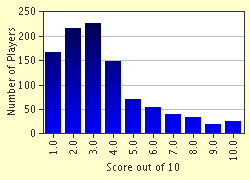Quiz Answer Key and Fun Facts
1. What is the junction of the coronal suture and the sagittal suture called on the adult skull?
2. How many separate bones comprise the skull? (including the jaw)
3. Which of these muscles is not supplied by the trigeminal nerve?
4. What is the name of the venous sinus that lies adjacent to the pituitary gland?
5. What is the name given to the flap of dura mater which separates the two cerebral hemispheres?
6. The trochlear nerve (CN IV) innervates only one muscle, involved in eye movement, which is it?
7. Which of these nerves does not provide sensation to the tongue?
8. Which nerve (or branches thereof) would be vulnerable during surgery to remove a tumour of the parotid gland?
9. The vagus nerve (CN X) exits the skull via which foramen?
10. To where does the endolymph in the inner ear drain directly?
Source: Author
chickenkev
This quiz was reviewed by our editing team before going online.
Any errors found in FunTrivia content are routinely corrected through our feedback system.


